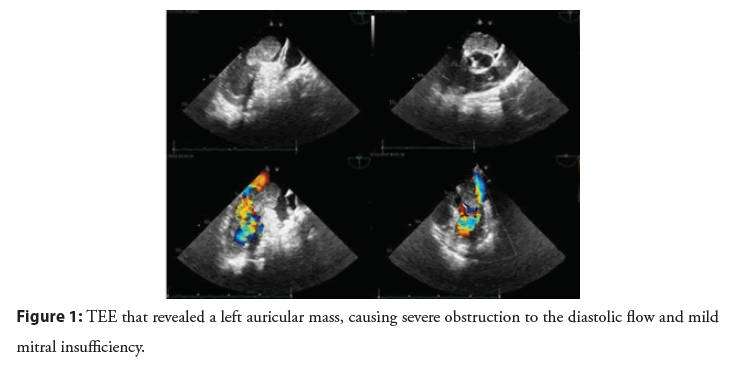Image Article - Interventional Cardiology (2021)
Recurrence of non-familial cardiac myxomas
- Corresponding Author:
- Lisa Ferraz
Department of Cardiovascular, Centro Hospitalar do Baixo Vouga, Aveiro, Portugal,
E-mail: lisacostaf@gmail.com
Received date: May 18, 2021; Accepted date: June 01, 2021; Published date: June 08, 2021
Abstract
Description
A 70 year old woman without family history went to the hospital for progressive tiredness and dyspnea for two weeks. Was documented sinus tachycardia with signs of congestion on chest X-ray, desaturation requiring non-invasive ventilation and high type B natriuretic peptide. Transthoracic echocardiogram (TTE) showed a large left atrial mass with insertion by a pedicle in the interauricular septum, leading to increased pressure in the left atrium and pulmonary artery, mitral stenosis and mild mitral insufficiency. A transesophageal echocardiogram (TEE) confirmed the presence of this mass. The patient was submitted to excision of this mass, which the pathological anatomy confirmed was an auricular myxoma. Due to recurrence of symptoms two years after, realized TTE and TEE that revealed a left auricular mass, causing severe obstruction to the diastolic flow and mild mitral insufficiency (Figure 1) (Videos 1 and 2).
Video 1: TEE that revealed a left auricular mass.
Video 2: TEE that revealed a left auricular mass, causing severe obstruction to the diastolic flow and mild mitral insufficiency.
Discussion
The vast majority of cardiac myxomas are sporadic, only 7% occur in the context of a large syndrome called the Carney complex, an autosomal dominant disease characterized by the presence of cardiac and skin myxomas, skin hyperpigmentation, and primary pigmented nodular adrenocortical disease. Cardiac myxomas are located predominantly in the left atrium (more than 75% of cardiac myxomas are seen in the left atrium) and are most frequently pedunculated and heterogeneous ecogeneity [1-3].
Conclusion
This case highlights the importance of recurrences of cardiac myxomas, which, although rare, are more frequent in men and in the presence of family syndromes (namely Carney Complex Syndrome), can occur in the absence of these characteristics.
Conflict of Interest
The authors have no conflicts of interest to declare.
References
- Saric M, Armour AC, Arnaout MS, et al. Guidelines for the use of echocardiography in the evaluation of a cardiac source of embolism. J Am Soc Echocardiogr. 29(1): 1-42 (2016).
- Mendoza C, Bernstein E, Ferreira A. Multiple recurrences of non-familial cardiac myxomas: A report of two cases. Tex Heart Inst J. 34(2): 236 (2007).
- Carvalho MS, Andrade MJ, Abecasis J, et al. Understanding cardiac myxoma recurrence: A case report. Rev Port Cardiol. 32(3): 239-242 (2013).


